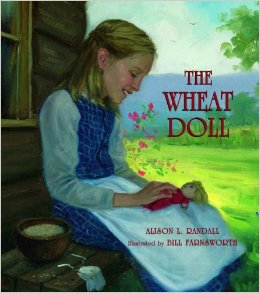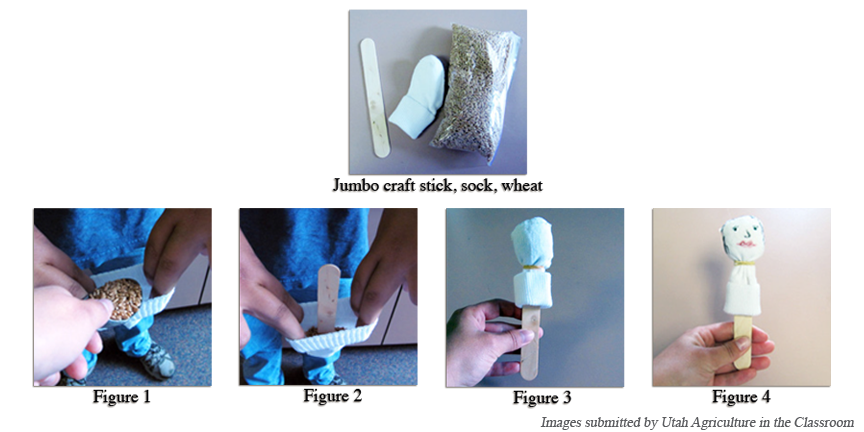 Relevancy and Engagement
agclassroom.org/ia/
Relevancy and Engagement
agclassroom.org/ia/
Lesson Plan
Wheat and Dolls
Grade Level
Purpose
Students investigate how wheat is grown and processed into flour and other wheat products and create wheat puppets to perform a play. Grades 3-5
Estimated Time
Materials Needed
Engage:
Activity 1: The Wheat Doll
- The Wheat Doll by Alison L. Randall
Activity 2: Theatrically Exploring Wheat
- White 0–6 months bobby socks, 1 per student
- Jumbo craft sticks, 1 per student
- Rubber bands, 1 per student
- 3 cups hard red wheat
- Tablespoons for measuring
- Wheat Theme activity sheets
- Combine toy/cutout (Theme 1)
- Wheat Bundle (Theme 2)
- Wheat Grinder Kit (Theme 2)
- Utah Agriculture Activity Map (Theme 3)
- Weslandia by Paul Fleischman (Theme 6)
Suggested Wardrobe Supplies:
- Low temperature mini glue guns
- Fabric scraps
- Sequins
- Feathers
- Pipe cleaners
- Wiggle eyes
- Felt
- Yarn
- Sharpies (makeup)
Vocabulary
combine: a machine that cuts crops and separates the seeds from the rest of the plant, combining the harvesting, threshing, and winnowing processes
wheat: a cereal plant grown in temperate climates, the grain of which is ground to make flour for bread, pasta, pastry, etc.
Did You Know?
- Wheat was first planted in 1777 in the United States as a hobby crop (planted for pleasure rather than for profit). It is now grown in 42 states as a small grain for profit.1
- One bushel of wheat weighs approximately 60 pounds which can produce 42 loaves of white bread.1
- One bushel of wheat contains about 1 million kernels.1
- There are more than 600 pasta shapes made from durum wheat. One bushel of this type of wheat can produce about 42 pounds of pasta or 210 spaghetti servings.1
Background Agricultural Connections
Wheat is grown on more acreage than any other crop in the world, and it is a staple food for much of the world’s population. History shows that the first people to eat wheat probably did so approximately 17,000 years ago by chewing kernels of the wild grain. Wheat was domesticated sometime around 10,000 years ago and eventually spread worldwide, taking root in the Americas with the arrival of Spanish settlers.
Pioneers brought wheat seeds with them across the country to Utah. Wheat is one of the few crops that produces well in Utah’s arid climate without irrigation. Today, approximately one quarter of Utah’s wheat crop is produced on dry land farms without irrigation. Utah wheat farmers grow mostly hard red winter wheat, which is used to make breads and hard rolls, and some soft white wheat, which is used as a cake or pastry flour.
Wheat varieties are divided into groups based on when they are planted and whether their grain is hard or soft, red or white. Hard wheat has a higher protein content, while soft wheat has a higher carbohydrate content. The coloration comes from pigments in the bran, which is removed during the flour milling process. There are five major types of wheat grown in the United States: hard red winter, hard red spring, soft red winter, white, and durum. Durum wheat is used specifically for making pasta. When most people think of wheat, they picture bread and pasta, but wheat is also used to make wall paper paste, adhesive, pet food, pet chew toys, and more.
Wheat is a cool season crop. Growth begins at temperatures of about 37° to 39°F. Its optimal growing temperature is 77°F. Spring wheat is planted as soon as soil conditions permit. Farmers are careful not to till fields that are soaked and muddy. Winter wheat is planted in the fall and harvested the following summer because it develops best after exposure to cold, winter temperatures. Whether planting in the spring or fall, farmers prepare the field before seeding. A disk pulled behind a tractor is used to turn and loosen the soil and to kill any young weed plants. The disk has a set of metal “plates” that dig deep into the soil. A disk shovel cuts a trench into the soil so the seeds can drop one at a time, and then loose soil is pressed over the newly planted seeds. Wheat is planted in rows five to six inches apart by a machine called a grain drill.
The seed begins to grow when there is enough moisture in the soil. Growth begins when tiny roots stretch down into the soil. Soon afterward, a small shoot emerges through the soil surface. Starch within the wheat seed provides the plant with its first nourishment. As the plant grows leaves, it begins to use photosynthesis to make food from the energy of the sun. Its roots get nutrients (minerals and water) from the soil. In the spring, the wheat plant grows six to eight leaves per stem and sends up three to ten stalks of golden flowers called heads.
Wheat must be dry before it can be harvested. In Utah, and most other wheat producing states, most harvesting occurs in late July or early August. With one pass through the field, a combine machine is used to cut, separate, and clean the wheat. Utah farmers produce 40–50 bushels of wheat per acre. One bushel is equivalent to 60 pounds of wheat containing 13.5% moisture. The farmer stores the grain in bins on the farm or at storage structures called “elevators” prior to shipment and processing. During processing, wheat is ground into flour at a mill. Bran, the outer layer of the wheat kernel, is often added to breakfast cereals and breads for nutritious fiber. Wheat contains carbohydrates, protein, minerals, and vitamins. George Washington, the first president of the United States of America, was a farmer who recognized the value of agriculture. In 1788 George Washington wrote, “I hope, some day or another, we shall become a storehouse and grainary for the world.” If only George could see where the United States is now—wheat is grown in almost every state in the country. 
Machine Power, Utah Agriculture in the Classroom
Engage
- Display several different types of boxed pasta such as macaroni noodles, spaghetti noodles, and lasagna noodles. Begin a discussion with the students about where there pasta comes from. Ask, "Can anyone tell me what the primary ingredient used to make pasta?" Allow the students to pass around the boxes of uncooked pasta and tell them to read the list of ingredients. Then, ask the same question, "What is the primary ingredient used to make pasta?" (wheat). Ask the students to name other food products that contain wheat. Such answers may include bread, cereal, crackers, pretzels, pizza dough, and cookies.
- Tell the students that farmers grow wheat. This includes planting, germination, growth, and harvesting. After wheat is harvested, it is transported to a processing plant for food products where the wheat seed can be made into flour and then pasta or other wheat products. Many hands go into the making of pasta and other wheat products before it winds up on our dinner plates.
- Show the video clip North Dakota Ships Durum Wheat which follows wheat from the farm to the pasta product it becomes. As you show the video, ask the students to watch closely and determine how many different types of workers (careers) they can identify. (wheat grower/farmer, truck driver, wheat processing plant CEO, wheat inspector, and wheat technicians)
Explore and Explain
Activity 1: The Wheat Doll
 Tell students that you are going to read The Wheat Doll by Alison L. Randall. Ask them to make predictions about the text from the title using their prior knowledge about wheat and pioneers.
Tell students that you are going to read The Wheat Doll by Alison L. Randall. Ask them to make predictions about the text from the title using their prior knowledge about wheat and pioneers.- Read The Wheat Doll to students, and then discuss how their predictions compared to the story.
- Ask students what they learned and what they can infer about wheat and the pioneer lifestyle from the text. For example, where does Mary Anne’s family live? What is the climate? In what time period does Mary Anne live?
- Read the “More About Mary Anne” section at the end of The Wheat Doll book. Ask the students if their inferences and conclusions about wheat and the pioneer lifestyle were right.
Activity 2: Theatrically Exploring Wheat
- Share the background information and the diagram of a combine harvester with students.
- Split students into groups. Explain that they will be exploring wheat through wheat-themed plays that they will write and then perform with wheat puppets they create.
- Assign each group a wheat theme (suggestions attached).
- Ask students to create their “actors” as described below.
- Wheat Puppets
- Prepare a table with wardrobe supplies that students can select and take back to their table to apply.
- Give each student an infant sock, a rubber band, and a craft stick.
- Provide each group with a bowl of wheat (approximately . cup for a group of four) and a tablespoon.
- Students should hold open their sock and allow another student to carefully pour 2 tablespoons of wheat kernels into the sock (Figure 1).
- Gently insert the craft stick into the middle of the wheat (Figure 2).
- Tightly wrap the rubber band around the sock and stick approximately 1–1.5" from the toe of the sock (Figure 3).
- Students should design a costume for their wheat puppet based on the characters in their script (Figure 4).

- Wheat Puppets
- Instruct students to write their scripts using the prompts on their Wheat Theme activity sheet.
- Ask groups to perform their wheat puppet play for the class.
Elaborate
-
As a class, grind wheat kernels into flour with a hand-grinder to make bread or tortillas. A Wheat Grinder Kit, including recipes for making bread and tortillas in a Ziploc bag is available for purchase.
-
Have students chew hard red wheat into gum.
Evaluate
After conducting these activities, review and summarize the following key concepts:
- Wheat is an agricultural product grown in Utah and other states.
- Wheat is primarily grown for food. It is processed into flour that can be made into many different types of food products such as bread and pasta.
- Wheat is the seed of a plant. The seed is separated from the plant when it is harvested by a machine called a combine.
Sources
Recommended Companion Resources
- A True Book: Wheat
- America's Heartland: Wheat Episodes
- Apples to Oregon
- Bread Comes to Life
- Bread Comes to Life
- Bread in a Bag
- Bread is for Eating
- Bread, Bread, Bread
- Farmer George Plants a Nation
- Follow Me Down to Nicodemus Town
- From Wheat to Bread
- Glorious Grasses: The Grains
- Grains Flowchart
- Modern Marvels: World's Largest Combine
- Pancakes for Breakfast
- Pancakes, Pancakes!
- The Wheat Doll
- Utah Agriculture Activity Map
- Wheat
- Wheat Bundle
- Wheat Grinder
- Wheat Weaving: How to Make a Corn Dolly